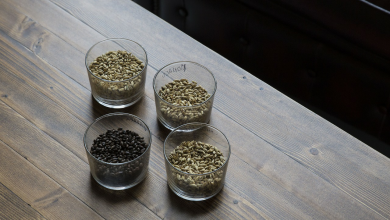What Is Pilsner Beer?

There are so many different varieties of beer that it’s hard to list them all. Beer styles can vary by region, taste, brew method, ingredients, tradition, appearance, and more. So how is a beer, such as a pilsner, defined precisely? Let’s explore this famous European-derived beer and discover what makes it so beloved by beer drinkers worldwide.
How Is Pilsner Defined?
In the world of beer, pilsner certainly stands on its own. Its defining and unique characteristics can be broken down as follows:
- Body – This beer includes a dense white head and a unique straw or gold color.
- Aroma – The aroma can be described as hops-inspired and grainy.
- Taste – Pilsner is known to have a smooth and clean taste consisting of hops bittering and grain.
All pilsner alcohol content tends to rest between four to five percent. While the characteristics mentioned above provide a base for defining pilsner against other brew varieties, there are many different unique aspects and flavors of pilsners offered throughout the world.
The History of Pilsner
Bavarian brewer Josef Groll first saw the need to develop a new beer in 1842 in the Czech Republic city of Pilsen. Such was the distaste for the beer available in the town that the citizens actually took to its city hall and poured 36 kegs of beer in the streets in front of the building.
Following the citizen’s beer revolt, an architect by the name of Martin Stelzer was hired to build a new brewery, and Josef Groll was hired as head brewer. The two men were tasked with developing a brewery and a brew that the town, and subsequently the world, could enjoy and be proud of.
It seems the designer and brewer chosen were the perfect pair for the job. To prepare for the task, Stelzer traveled throughout Europe to study brewery designs and technology. Upon returning, the renowned architect designed a state-of-the-art brewery on Pilsen’s Radbuza River. The newly designed brewery included aquifers with which to supply mineral-free water and tunnels for the lagering process. Upon completion, the brewery was called Bürgerbrauerei, which translates to “citizens brewery” in German.
Groll set about to develop the new brew that was to sweep the world by storm. As the son of a famous brewer in Bavaria, Groll had the knowledge to create the beer, but he also took a world trip of his own to learn about the latest brewing techniques being used. When he returned, the beer he developed became known as pilsner, named after the town in which it was brewed.
When the town’s citizens first tried Groll’s new beer on October 4th, 1842, they were enthralled right away at the flavor and unique golden color of the beer. Citizens in nearby areas began to sample the beer. Before long, it spread across the rest of Europe and into America and the rest of the world. Along the way, brewers developed their own variations of pilsner, which were dependent on local brewing styles and ingredients available. In the U.S., for instance, corn was added to the process, leading to the development of what was known as Post-Prohibition Lager.

How Is Pilsner Brewed?
The brewing process is unique to every different type of beer. When Groll developed the first pilsner, it was genuinely revolutionary in technique. During that time in the Czech Republic, beer was brewed with dark malts. Groll chose to brew his beer to a much lighter, golden color. With the mineral-free water being filtered into the brewery and Saaz noble hops, Groll was able to lager his brew into the beloved beer we’re familiar with today.
While the pilsner brew ingredients and techniques remain mostly the same in brewing today, variations have certainly developed. The previously mentioned American version, for instance, was crafted mainly by homebrewers and used corn and barley. Other variations differed in accordance with the water, grain, and yeast available to brewers.
Pilsner is not known to be the easiest to make by beer brewers, yet pilsners are one of the most-produced beer varieties worldwide because they’re simply worth it. When brewing pilsners, every small detail counts. The hops, water, yeast, and other ingredients – everything impacts the final product in a big way.
Different Pilsner Varieties
While the original Czech version can be dubbed the true pilsner, there have been a lot of variations developed over the years that have gained their own popularity with beer drinkers. Let’s take a look at a few.
- German Pilsner – In Germany, the pilsner variety developed there became quite well-known. The German-style beer carries its own unique traits by offering a medium hops bittering, a malt-inspired sweetness, pale straw color, and a smooth overall taste. German pilsner established a strong history right here in the U.S. through German immigrants in the 1800’s who began brewing the light golden beer.
- Canadian Pilsner – The popular Canadian-style pilsner was developed on the west coast of Canada. It is known to have a very hoppy flavor.
- American Pilsner – As mentioned previously, this American-style pilsner was developed through German-established breweries in the 1800s in the U.S. Through integrating corn into the process, this pilsner variety is known to be darker and sweeter.
- European Pilsner – European pilsners are every well-known. Such brands produce them as Amstel, Heineken, Stella Artois, and Grolsch.
- Icelandic Pilsner – This pilsner version of the beer is much lower alcohol content than others available due to local government regulations prohibiting alcoholic beverages outside government-run restaurants and bars.
Why Beer Drinkers Love Pilsners
Summer is the time you’re most likely to hear and see the most pilsner; this is because the brew is identified as being very refreshing. Due to its bright and clean body and taste, a certain complexity is known to shine through with pilsners. Drinkers enjoy being able to detect the distinct flavors encompassed within pilsners, which can range from fruit notes to earthy tones depending on the brewer and the area. Pilsner is also one of the less-heavy beers, which many appreciate for food pairing.

Pairing Your Pilsner
Just like wine pairing, there are certain foods you can pair your pilsner with to enhance your eating and drinking experience. Here are some pairings to try the next time you enjoy a pilsner:
- Salad
- Tuna
- Spicy dishes
- Trout
- Salmon
- Mexican dishes
- Asian dishes
- Cheeses, such as Muenster, Havarti, Monterey Jack, or American
- Summer vegetables, such as asparagus
Don’t feel constricted to only drinking pilsners with the foods mentioned above, though. Pilsner is one of those beer styles that can complement practically any meal or situation. Enjoy how you want to!
Well-Loved Craft Brewed Pilsners
Because we’re Microbrewery.com, we can’t resist delving into some of the best craft-brewed pilsners out there. Here’s a list of some noted and popular craft pilsners available:
- Bitburger Premium Pilsner – Flavors of honey, crackers, and biscuits comprise this spicy and bitter brew enjoyed by many.
- Victory Prima Pils – Brewed by the Victory Brewing Company, the Prima Pils is loved by its drinkers for bright flavors of citrus, malt, bread, pepper, and earth tones.
- Dust Bowl Brewing Hobo Pilsner – This bold pilsner has a strong bitterness and notes of greenery and citrus orange blossom.
- Brooklyn Pilsner – Brooklyn Brewery describes their popular pilsner as a “smooth malt with fresh and floral hops.”
- Farmstead Brewery’s Mary – It’s not just the unique bottle that draws beer drinkers to the Mary pilsner. This German-style pilsner boasts a traditional layered flavor coveted by many.
- Hometown Blonde – Food & Wine magazine describes this beer as “arguably the closest thing to a true German pilsner you’ll find made in the U.S today.” This pilsner is described as being crisp, light, and bright in flavor.
- Pivo Pils – Brewed in Paso Robles, this pilsner developed by Firestone Walker Brewing Co. features a lot of carbonation and a whole lot of hoppy flavor and aroma.
- Stoudts Brewing Company Pils – Lemon, bread, and hops are the flavors that make up this dryer version of pilsner out of Pennsylvania.
- Prince of Pilsen – With floral hints and flavors of lemon, many beer drinkers appreciate this carbonated pilsner as being an excellent choice.
- Reality Czech – It’s not just the name that gives this Moonlight Brewing Co. beer its likability. Pilsner drinkers enjoy this beverage for its floral, bready, and grassy flavors carried on a sweet and dry body.
- Burial Beer Shadowcock Pilsner – This pilsner has a high bitterness but is paired with a sweetness all the same. Bread, biscuit, and cracker notes are also present.
- Pfaffenheck – This pilsner brewed in Massachusetts by Night Shift Brewing is loved for its malt-flavored and smooth taste.
- Heater Allen Pils – While this heavier pilsner beer certainly isn’t sweet, it does contain well-balanced floral and citrus notes that are loved by its drinkers.
- Fresh Cut – Spicy and grassy is just two of the flavors used to describe this smooth beer developed by the Peak Organic Brewing Co. in Maine.
- Alvarado Street Brewery Peninsula Pilsner – This unique pilsner offers hoppy flavors of cedar and spruce.
- 5 O’clock Pils – Known for being smooth and full-bodied, the 5 O’clock Pils out of Texas delivers a great taste with hints of toast and lemon to be enjoyed.
- Big Grove Brewery – This light and smooth offering from Big Grove Brewery offers lemongrass notes and a fresh aroma of linen.



